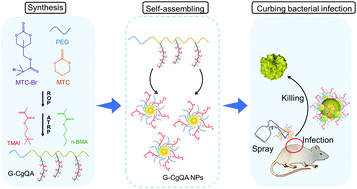Combating drug-resistant bacterial infection using biodegradable nanoparticles assembled from comb-like polycarbonates grafted with amphiphilic polyquaternium†
Abstract
Bacterial infection is a serious clinical threat. The misuse of antibiotics has already resulted in the emergence of antibiotic-resistant strains of pathogenic bacteria. Efficient membrane-destructive antibacterial agents are considered as an alternative, promising solution against bacterial infection. Herein, we prepared a new type of comb-like cationic, polyethylene glycol (PEG) block polycarbonates with polyquaternium arms (G-CgQAs). The amphiphilic G-CgQAs could self-assemble into about 60 nm sized nanoparticles (NPs) with positive charges (20~30 mV). G-CgQA-3 NPs with an appropriate hydrophobic–hydrophilic balance in the polyquaternium arms showed antibacterial activity against Gram-negative, Gram-positive, and drug-resistant strains at low concentrations (MIC 64–128 μg mL−1) and low hemolysis (HC50 > 2000 μg mL−1). In vivo anti-infection tests indicated G-CgQA-3 NPs could highly inhibit the growth of vancomycin-resistant bacteria by spraying on wounds. Collectively, G-CgQA NPs hold great promise for the prevention of infection, serving as new antibacterial agents. This study also highlights the significance of a hydrophobic block in positive polyquaternium arms to facilitate the antibacterial activity of cationic, quaternized polymers. The design of comb-like amphiphilic cationic polycarbonates provides a new method for manufacturing antibacterial nano-agents.



 Please wait while we load your content...
Please wait while we load your content...